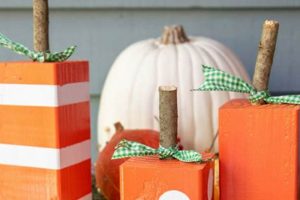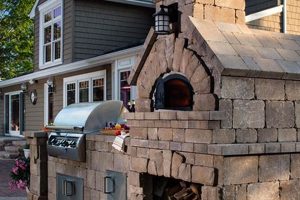The creation of autumnal decorations from wood offers a personalized approach to seasonal aesthetics. These handcrafted items, often shaped to resemble gourds associated with the fall harvest, provide an alternative to commercially produced or naturally derived decorative elements. As an example, shaped wooden cutouts can be painted and embellished to mimic the appearance of pumpkins.
The appeal of constructing these decorations stems from the opportunity to customize designs, promoting individual creativity and allowing for the integration of unique artistic expressions into seasonal displays. The utilization of wood provides durability and longevity, enabling repeated use across multiple seasons. Historically, crafting decorative objects from readily available materials has been a common practice, reflecting resourcefulness and a connection to natural cycles.
Subsequent sections will detail various techniques for constructing these decorative items, including material selection, cutting and shaping methods, painting and finishing options, and examples of potential embellishments. These instructions facilitate the production of customized autumnal ornaments suitable for both indoor and outdoor display.
Construction Recommendations for Wooden Autumnal Decorations
The following guidelines offer practical advice for achieving optimal results when fabricating decorative autumnal objects from wood. Adherence to these recommendations will enhance both the aesthetic appeal and structural integrity of the finished items.
Tip 1: Material Selection: Choose wood types appropriate for intended use. Exterior applications necessitate weather-resistant species like cedar or redwood. Interior projects can utilize more economical options such as pine or plywood. Consider wood grain and knot placement for visual impact.
Tip 2: Template Acquisition or Creation: Employ precise templates to ensure consistent shaping. Existing templates may be purchased or downloaded. Alternatively, create custom templates from cardboard or durable paper to personalize the design.
Tip 3: Precise Cutting Techniques: Utilize appropriate cutting tools, such as jigsaws or band saws, to accurately follow template outlines. Securely clamp the wood to a stable surface to minimize vibration and ensure smooth cuts. Prioritize safety through the use of appropriate personal protective equipment.
Tip 4: Surface Preparation: Thoroughly sand all surfaces to remove splinters and create a smooth base for finishing. Progress through increasingly finer grits of sandpaper to achieve a professional-quality result. Remove all sanding dust prior to applying finishes.
Tip 5: Finish Application: Select finishes appropriate for the intended environment. Exterior decorations require weatherproof paints or sealants to prevent moisture damage. Interior decorations can utilize a wider range of finishes, including stains, varnishes, and acrylic paints. Apply finishes in thin, even coats, allowing adequate drying time between applications.
Tip 6: Embellishment Considerations: Incorporate embellishments thoughtfully to enhance the visual appeal. Options include painting details, adding stems made from twigs or branches, attaching artificial leaves, and applying decorative hardware. Ensure embellishments are securely affixed using appropriate adhesives or fasteners.
Tip 7: Secure Assembly: Employ robust adhesives or fasteners to connect multiple pieces, if applicable. Wood glue provides a strong, durable bond for interior applications. Screws or nails offer greater holding power for exterior projects. Countersink fasteners to create a flush surface.
Following these guidelines during the construction process promotes the creation of durable, visually appealing, and personalized autumnal decorations. Attention to detail in each step contributes to a high-quality finished product.
The subsequent sections will provide specific project ideas and instructions, further illustrating the practical application of these recommendations.
1. Material Durability
Material durability directly impacts the lifespan and aesthetic appeal of wooden autumnal decorations. The selected wood species dictates resistance to environmental factors such as moisture, temperature fluctuations, and potential pest infestation. For external applications, neglecting material durability can result in warping, cracking, or decay, necessitating premature replacement. Conversely, utilizing durable materials, such as treated lumber or naturally rot-resistant woods, ensures extended usability and reduces long-term maintenance costs. A practical example is the use of cedar for outdoor wooden pumpkins, which naturally resists rot and insect damage compared to untreated pine. The selection of robust materials represents a critical element in the overall value and sustainability of handcrafted seasonal displays.
The cause-and-effect relationship between material choice and the longevity of wooden autumnal decorations is evident in the weathering process. Softer woods, like pine, are more susceptible to water absorption, leading to expansion and contraction cycles that weaken the material structure over time. Hardwoods, such as oak or maple, offer greater resistance to these effects but often require more specialized tools for cutting and shaping. Furthermore, the chosen finish interacts with the wood; a sealant applied to a durable wood enhances its protection, while the same sealant applied to a less durable wood may only offer limited benefits. This highlights the synergistic impact of selecting both appropriate materials and finishes for optimal performance.
In summary, material durability constitutes a foundational element in the creation of lasting wooden autumnal decorations. The choice of wood directly affects the resistance to environmental stressors, thus influencing the overall lifespan and maintaining the visual appeal of the handcrafted items. Understanding this connection is crucial for maximizing the investment in time and resources when crafting seasonal displays and ensuring their continued enjoyment across multiple years. A well-informed decision regarding material selection mitigates potential structural issues and preserves the aesthetic value of these handcrafted creations.
2. Shape Precision
Shape precision constitutes a critical element in the successful execution of wooden autumnal decorations. Accuracy in replicating the desired form directly influences the aesthetic appeal and recognizability of the finished product. Deviations from the intended shape can diminish the perceived quality and compromise the overall visual impact of the crafted item.
- Template Accuracy
The fidelity of the template used directly impacts the precision of the resulting shape. Imperfections or inaccuracies in the template will be transferred to the wood during the cutting process. Using high-quality, accurately scaled templates, whether commercially produced or self-made, is essential for achieving the desired form. For example, a warped or uneven template will yield a distorted wooden shape, compromising the intended aesthetic.
- Cutting Technique
Employing appropriate cutting techniques is crucial for maintaining shape precision. The use of dull blades, excessive force, or improper tool handling can result in chipped edges, irregular curves, and deviations from the template outline. Employing sharp blades, steady hand movements, and appropriate cutting speeds are essential for achieving clean, precise cuts that accurately reflect the template’s form. Freehand cutting, without a template, relies entirely on skill and can introduce significant inaccuracies.
- Sanding and Refinement
Sanding and refinement processes contribute to shape precision by smoothing out imperfections and refining edges. Over-sanding or uneven sanding can distort the intended shape, particularly in areas with delicate curves or sharp angles. Utilizing appropriate sanding techniques, employing progressively finer grits of sandpaper, and carefully monitoring the sanding process are essential for maintaining the desired shape while achieving a smooth, refined surface.
- Assembly Accuracy
For decorations involving multiple pieces, accurate assembly is paramount for maintaining overall shape precision. Misalignment or improper joining of components can result in a distorted or asymmetrical final product. Employing precise measuring techniques, using appropriate adhesives or fasteners, and ensuring proper alignment during assembly are essential for creating a cohesive and visually accurate finished piece.
These facets collectively underscore the importance of shape precision in the creation of wooden autumnal decorations. From template creation to final assembly, meticulous attention to detail and adherence to precise techniques contribute significantly to the overall aesthetic appeal and perceived quality of the crafted items. Neglecting shape precision can detract from the intended visual impact and compromise the value of the finished product, highlighting the importance of careful execution in every stage of the crafting process.
3. Paint Adhesion
Paint adhesion represents a critical factor in the long-term aesthetic quality and durability of finished wooden autumnal decorations. Insufficient adhesion leads to premature chipping, peeling, and overall degradation of the painted surface, diminishing the visual appeal and requiring costly repairs or replacements. Proper surface preparation and the selection of appropriate primers and paints are essential for ensuring robust paint adhesion.
- Surface Preparation: The Foundation of Adhesion
Adequate surface preparation is paramount for establishing a strong bond between the paint and the wood substrate. Failure to properly prepare the surface can result in paint failure, regardless of the quality of the paint used. Sanding removes imperfections, creates a slightly roughened surface for increased mechanical bonding, and removes contaminants that may interfere with adhesion. Cleaning removes residual dust, grease, and other substances that can inhibit paint adherence. For example, sanding the wood to 220-grit and then wiping it down with a tack cloth before priming promotes optimal adhesion.
- Primer Selection: Bridging the Gap
Primer acts as an intermediary layer between the wood and the topcoat, improving paint adhesion and providing a uniform surface for color application. Primers designed for wood often contain additives that seal the porous surface, preventing excessive paint absorption and promoting even coverage. Using a stain-blocking primer is particularly important when painting wood with knots or pre-existing stains, as it prevents these blemishes from bleeding through the topcoat. An oil-based primer typically offers superior adhesion to bare wood compared to latex primers.
- Paint Composition: Matching the Material
The chemical composition of the paint influences its ability to adhere to wood surfaces. Paints formulated specifically for wood contain binders that provide flexibility and resist cracking or peeling due to wood expansion and contraction. Exterior paints must also possess UV resistance and water repellency to withstand the effects of sunlight and moisture. Acrylic latex paints are generally suitable for wooden pumpkins due to their flexibility and ease of application, but oil-based paints offer greater durability and resistance to abrasion. Careful consideration of the paint’s intended application environment is crucial for optimal performance.
- Application Technique: Optimizing the Bond
Proper application techniques maximize paint adhesion by ensuring uniform coverage and minimizing the formation of weak points in the paint film. Applying thin, even coats of paint, allowing sufficient drying time between coats, and avoiding excessive brushing or rolling promote optimal adhesion. Applying paint in humid conditions can inhibit proper drying and reduce adhesion. Furthermore, back-brushing or back-rolling immediately after applying the paint helps to work it into the surface and improve bonding. Adhering to recommended application guidelines from the paint manufacturer is crucial for achieving the best possible results.
The successful combination of proper surface preparation, strategic primer selection, compatible paint composition, and precise application techniques represents the cornerstone of robust paint adhesion for wooden autumnal decorations. A diligent approach to these elements translates directly into enhanced durability, prolonged aesthetic appeal, and minimized maintenance requirements, contributing to the overall value and longevity of these handcrafted decorative objects. This meticulous attention to detail ensures that the painted finish remains intact and visually appealing for years to come.
4. Design Complexity
Design complexity in the context of wooden autumnal decorations directly influences the time investment, skill requirements, and ultimately, the visual impact of the finished product. Ranging from simple silhouettes to elaborate multi-layered constructions, the level of intricacy significantly affects the crafting process and the resulting aesthetic.
- Silhouette Simplicity
The most basic approach involves cutting a simple pumpkin shape from a single piece of wood. This requires minimal tools and skill, making it suitable for beginners. Examples include basic circular or oval shapes with a stem. The visual impact relies on paint and embellishments rather than intricate carving or assembly. This simplicity allows for mass production and efficient use of materials.
- Layered Construction
More complex designs utilize multiple layers of wood to create depth and dimension. This approach allows for variations in color, texture, and shape within a single decoration. For example, a pumpkin could have a separate face layer with carved features attached to a solid background layer. Layered construction necessitates precise cutting and assembly skills, increasing the time investment.
- Intricate Carving
Designs involving detailed carving demand advanced woodworking skills and specialized tools, such as carving knives or rotary tools. Intricate carving can create realistic textures and detailed patterns on the surface of the wooden pumpkin. Examples include carving realistic pumpkin ridges, facial expressions, or leaf patterns. This level of complexity significantly increases the risk of errors and material wastage.
- Embellishment Integration
The integration of embellishments, such as metal accents, twigs, or fabric, can further increase the design complexity. This requires careful planning and execution to ensure the embellishments are securely attached and visually integrated into the overall design. For example, adding a twisted twig as a stem or attaching metal leaves requires precise placement and secure fastening. The successful integration of embellishments enhances the visual appeal but also increases the time and skill required.
These diverse levels of design complexity offer a spectrum of options for crafting wooden autumnal decorations. The choice depends on the crafter’s skill level, available tools, and desired aesthetic. While simple silhouettes provide a quick and accessible option, more intricate designs offer greater visual impact and creative expression. Regardless of the chosen complexity, careful planning and execution are essential for achieving a satisfactory result, producing seasonal decorations that reflect individuality and craftsmanship.
5. Display Location
The display location fundamentally influences the material selection, construction techniques, and finishing choices employed in the creation of do-it-yourself wooden pumpkins. The anticipated environment dictates the level of weather resistance required, the potential for physical stress, and the desired aesthetic compatibility with the surroundings. For example, a wooden pumpkin intended for outdoor placement necessitates durable, weather-resistant materials and finishes capable of withstanding exposure to moisture, sunlight, and temperature fluctuations. Conversely, an indoor display allows for a wider range of materials and finishes, prioritizing aesthetic considerations over environmental resilience. The location, therefore, acts as a primary determinant in the entire crafting process.
Consider the practical implications: Outdoor placement necessitates the use of treated lumber or naturally rot-resistant wood species like cedar or redwood, coupled with exterior-grade paints or sealants to prevent deterioration. Assembly methods must also account for expansion and contraction due to temperature variations. An indoor display, however, may utilize less expensive materials such as pine or plywood and a wider array of finishes, including acrylic paints or varnishes. The aesthetic considerations also differ: outdoor decorations may require brighter, more vibrant colors to stand out against natural surroundings, while indoor displays can incorporate more subtle or sophisticated color palettes to complement existing interior dcor. Furthermore, the size and scale of the wooden pumpkin should be proportional to the display area, whether it be a sprawling front yard or a cozy fireplace mantle. Neglecting the influence of location leads to premature degradation, aesthetic disharmony, and ultimately, a compromised decorative outcome.
In conclusion, the intended display location represents a crucial, often underestimated, factor in the design and construction of do-it-yourself wooden pumpkins. The choice of materials, construction methods, and finishing techniques must align with the environmental demands and aesthetic considerations of the intended setting. While indoor displays offer greater flexibility, outdoor applications demand careful planning and execution to ensure longevity and visual appeal. Understanding and addressing these location-specific requirements are essential for creating handcrafted decorations that not only enhance the seasonal ambiance but also endure the test of time.
Frequently Asked Questions
The following addresses common inquiries concerning the construction, materials, and maintenance of handcrafted autumnal decorations made from wood. The intent is to clarify potential ambiguities and provide guidance for optimal results.
Question 1: What wood types are most suitable for outdoor applications?
Weather-resistant species are recommended for decorations exposed to the elements. Cedar, redwood, and treated lumber exhibit natural resistance to rot and insect damage, extending the lifespan of outdoor displays.
Question 2: How can paint adhesion be maximized on wooden surfaces?
Proper surface preparation is crucial. Sanding removes imperfections and creates a textured surface for improved adhesion. Priming provides a uniform base and seals the wood, preventing excessive paint absorption.
Question 3: What tools are essential for cutting intricate designs?
Jigsaws and band saws offer maneuverability for curved cuts. Rotary tools with specialized bits facilitate detailed carving. Safety equipment, including eye protection and dust masks, is also necessary.
Question 4: How can warping be prevented in outdoor wooden decorations?
Sealing all surfaces with a weather-resistant finish minimizes moisture absorption. Constructing decorations from multiple, thinner pieces of wood reduces the risk of warping compared to using a single, thick piece.
Question 5: What are the considerations for assembling multi-piece wooden pumpkins?
Accurate measurements and precise cutting are essential for proper alignment. Wood glue provides a strong bond for interior applications, while screws or nails offer greater holding power for exterior projects.
Question 6: How can the longevity of painted wooden pumpkins be ensured?
Regular cleaning removes dirt and debris that can degrade the paint finish. Applying a protective topcoat, such as a clear sealant, shields the paint from UV damage and abrasion.
The information provided addresses frequently encountered challenges in the creation and maintenance of wooden autumnal decorations. Applying these principles enhances both the aesthetic appeal and structural integrity of handcrafted items.
The succeeding section explores advanced design considerations for more elaborate and personalized decorations.
Concluding Remarks on DIY Wooden Pumpkins
This exploration has outlined various considerations integral to the successful fabrication of do-it-yourself wooden pumpkins. From material selection and precise cutting techniques to surface preparation, painting methodology, and appropriate display locations, each stage requires careful attention to detail to ensure both aesthetic appeal and structural longevity. The design complexity is also important, as it affects both the time needed to create a specific diy wooden pumpkins and a specific level of experience in woodworking.
The construction of these seasonal decorations offers a tangible outlet for creative expression and resourcefulness. By adhering to the guidelines presented herein, individuals can produce durable, visually engaging autumnal ornaments that enhance their surroundings for years to come. The pursuit of such endeavors contributes to the preservation of traditional crafting skills and fosters a deeper connection to seasonal cycles, and creating a diy wooden pumpkins is a greate way to achieve that.







